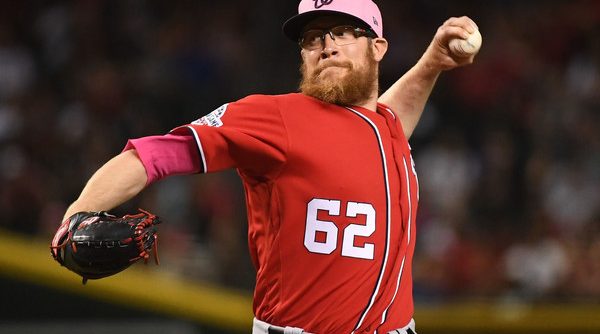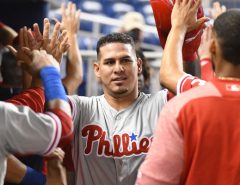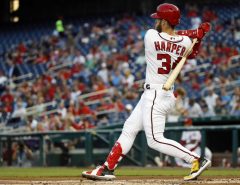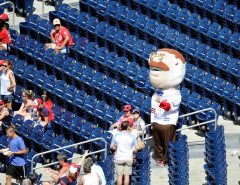This time last year, Nationals fans were watching implosion after implosion after implosion coming from the bullpen—leading to the worst reliever ERA in the majors. Mike Rizzo, doing what he does best, went out and formed The Law Firm of Kintzler, Madson, and Doolittle. The second half of 2017, the Nats bullpen was one of the better in the majors. After the season, he also convinced Brandon Kintzler to eschew more high-profile closer roles, and return to DC for a chance at a title. How much better has 2018 been?
A cursory look at the Nationals top four relieviers: Sammy Solis, Kintzler, Ryan Madson, and Sean Doolittle looks as though only Doolittle is pulling his weight. Their respective ERAs: 4.11, 3.48, 4.50, and 1.53. This, however, does not give the full picture. Each has had a bad outing or two that are greatly skewing their overall numbers.
Kintzler’s ERA and FIP (3.48 vs. 3.34) are almost identical, indicating his ERA should be where it’s at. A deeper look into Kintzler’s recent trends shows a lights-out option in the late innings. Like most of the team, he had a terrible start to the season—surrendering the grand slam in the home opener against the Mets, blowing a 2-1 lead in the 7th the following game—surrendering 2 ER, and giving up the winning run to complete the Mets’ sweep. Since then, he has been the second most reliable reliever. Over his 16.2 IP, he has a 0.52 ERA. He is holding opponents to a paltry .504 OPS-against. While he has never been a strikeout pitcher, he has found something over this stretch—K-ing 8.1 per 9 IP. His career K/9 is 6.21, including a minuscule 4.92/9 in all of 2017. Perhaps he and pitching coach Derek Lilliquist found something: He is throwing his slider about 50% less (14.0% in ’17, 7.2% in ’18) and relying more on his changeup (4.3% in ’17 vs. 12.1% in ’18).
Of the big three, Ryan Madson has been the most troubling. He wasn’t giving up many runs, but he was far too hittable—opponents were batting .289 against him with a .357 OBP, through his first 10 outings. Then on April 18, with the Nationals leading 4-2 in the 8th inning, Madson was summoned to pitch his third consecutive day. The result was 2/3rds of an inning, 5 hits, 6 ER, a walk and a strike out. The Mets would score nine runs that inning. Ten days (and just two appearances) later, he would surrender three hits and the game tying run in the 8th inning against Arizona in a game the Nationals would eventually lose in extra innings. Through his first 14 appearances, his BAA was .339. After getting pulled against Pittsburgh after giving up a hit, an HBP, and an unearned run as a result of an error, there were rumblings about what was wrong with Madson? He had only given up earned runs in three of his first 16 appearances, but he was having trouble getting people out—only four of those outings was a clean inning. Since getting pulled against the Pirates, the old Madson seems to have found his groove. His last four appearances: 3.2 IP, 1 hit, 0 ER, 1 walk, 5 Ks, .091 BAA. He isn’t getting hit hard either—he has just a 23.2% hard hit rate, lower than even his favorite closer.
The Nationals closers have been a line of nerve-wracking, panic-inducing line of stress. Since 2012, Nationals fans have lost appetites and gained grey hair watching Drew Storen, Rafael Soriano, and Jonathan Papelbon turn leads into circuses. 2016 offered a brief respite after acquiring Mark Melancon (costing Felipe Rivero/Vasquez, who has been dominant the last two seasons), before the Cirque de Blown Save returned in 2017. Mike Rizzo probably paid the steepest price he has ever paid for relievers Madson and Doolittle when he gave up Blake Treinen (currently the A’s closer, with a 0.98 ERA) and Jesus Luzardo (very promising lefty currently throwing 98 with quality secondary offerings in AA, per reports). However, Doolittle has been worth the price. Mike Petriello recently wrote that the Doctor might be the best reliever in baseball. The numbers for Doooooo are staggering: 13.75 K/9—42.9% of his opponents. He has a 1.53 BB/9 and 0.51 WHIP. When opponents do make contact, it’s not very hard: 28.1% hard contact rate. Doolittle doesn’t try to trick anyone either—everyone knows what’s coming: a mid-90’s fastball. The problem is, they still can’t hit it. Doolittle recently called his fastball the equivalent of four different pitches because of his location, he has no problem throwing it up, down, in, or out for strikes. All three of his runs given up have come via the home run. He hasn’t given up more than one hit in any outing, and just once he walked more than one batter. Opponents are hitting just .102 off him. The ninth inning is closed for business.
The Nationals biggest problem has been getting to the Law Firm. Sammy Solis has been the best bridge to the Law Firm. While his 4.11 ERA stands out, but his 2.24 FIP indicates some bad luck. He relieved Madson in the 9-run meltdown, surrendering 2 ER, without recording an out. Since then, he has been pretty solid, posting a 2.25 ERA over his last 8 IP. While his walk rate is concerning (5.1/9) he is striking out enough to make up for it (12.9). He is getting a lot of groundballs (51.5%) and soft contact (23.5%). Solis carries an unsustainable .382 BABIP, given his groundball and the ability to induce soft contact.
Shawn Kelley returned from the DL to post a scoreless, if stressful, inning. After a walk and a loud out, he got a borderline called third strike to end the inning. Kelley’s problem has been the homerun: 3.89/9. The rest of his peripherals have been great: 12.86 K/9, 1.29 BB/9. His walk the other day was his first of the year. Opponents are hitting just .222 against him—unfortunately half of his hits go a long, long way leading to a .667 slugging against. What is most encouraging about Kelley’s last outing was his fastball. For the past year plus Kelley’s fastball has been down, averaging 91.8. He threw nine fastballs, averaging 92.9 MPH, topping out at 94.4. Where he got into trouble was his inability to locate his slider—throwing just one for a strike.
The rest of the options have been ugly. Trevor Gott has been ineffective—high walk rate (4.26/9), low K rate (5.68/9), while he is getting a good amount of groundballs (62.2%), opponents are making solid contact off him (36.8%). With a 95.8 average-MPH fastball, he has the stuff—but he isn’t missing bats nearly enough to be effective. Longman Carlos Torres has been hit hard: 8.22 ERA, 7.71 FIP. Wander Suero is unproven, Koda Glover is MIA.
With Daniel Murphy, Adam Eaton, Ryan Zimmerman, Brian Goodwin, Victor Robles, and Matt Wieters all currently on the DL, the Nats have played in a number of close games. Madson, Kintzler, and Solis have appeared in 20, 21, and 22 of the Nationals’ 41 games respectively. That’s a 79, 82, and 87 game pace for each. Last year, Bryan Shaw and Peter Moylan lead the Majors in appearances with 79. Solis is also the only lefty in the bullpen right now with Matt Grace hurt. The Nationals will need one more reliable arm—either from someone in house stepping up or bringing in someone. If Kelley can regain his form from 2016, they might not need to acquire anyone else. The bullpen has been pretty good, but the number of games the top relievers have appeared in is cause for concern.





Leave a Reply